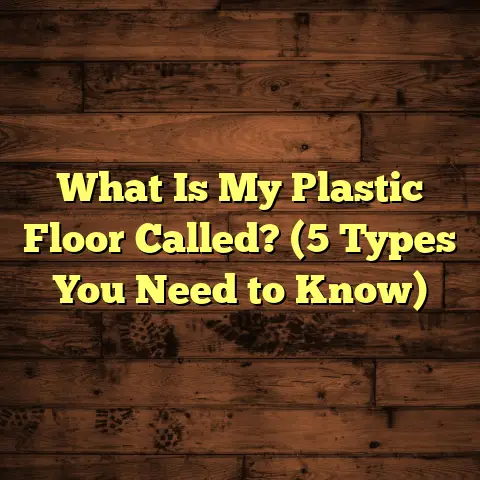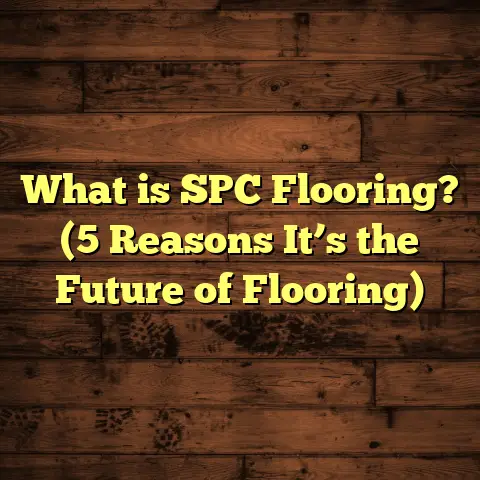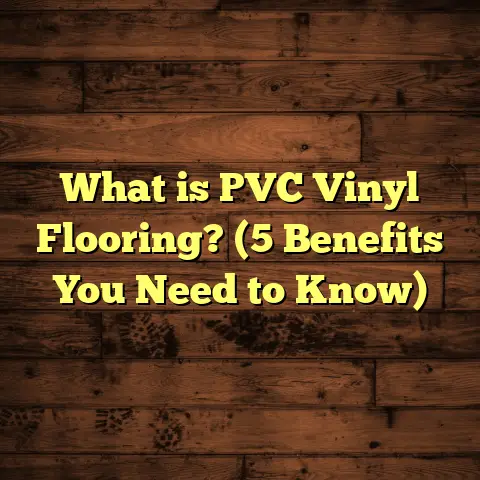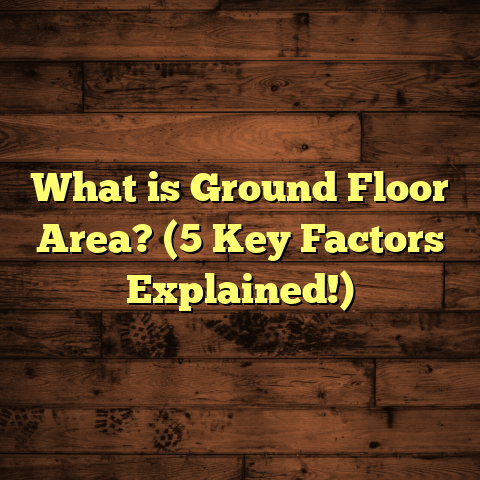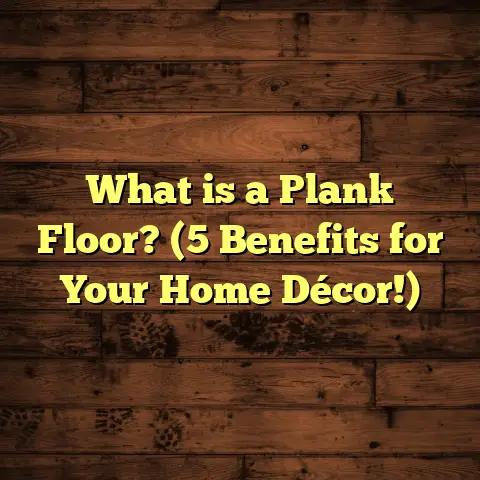What is a Hard Floor? (5 Key Benefits for Your Home)
Budgeting Your Flooring Options: My Journey and What You Should Know
When I started thinking about replacing the floors in my home, I was faced with a familiar challenge: how to balance budget and quality. I wanted floors that looked good, lasted a long time, and didn’t require daily babysitting with cleaning or repairs. But at the same time, I wasn’t ready to blow my savings or take out a loan just for flooring. Sound familiar?
I quickly learned that hard floors could offer exactly what I needed. They come in a range of prices, from affordable vinyl to expensive hardwood. This variety made it easier to find something that fit my budget without compromising on style or durability.
It’s also worth mentioning that the upfront cost isn’t the whole picture. A floor that lasts longer and needs less maintenance can save you money over the years. In fact, some hard floors pay for themselves through durability and lower upkeep costs.
I’d like to share what I’ve learned about hard floors, including why they might be the best choice for your home too.
What Is a Hard Floor?
Let’s start with the basics. You may have heard the term “hard floor” thrown around but wondered what exactly it means.
A hard floor is any flooring made from solid, tough materials rather than soft or cushioned ones like carpet. These materials include:
- Wood (solid hardwood and engineered hardwood)
- Tile (ceramic, porcelain, natural stone)
- Vinyl (luxury vinyl planks or sheets)
- Laminate (a wood-look synthetic surface)
- Concrete or polished cement
Hard floors are known for their firmness underfoot. They don’t compress or deform easily when you walk or stand on them. This makes them highly durable and capable of handling heavy foot traffic without damage.
How Hard Floors Differ From Other Flooring Types
Unlike carpet that tends to trap dust, dirt, and allergens deep within its fibers, hard floors are typically smooth and sealed surfaces. This design helps prevent accumulation of debris and makes cleaning much simpler.
Soft flooring options like carpet provide warmth and sound dampening but require more care and can wear out faster. On the other hand, hard floors resist stains, scratches, and moisture better when properly installed and maintained.
The 5 Key Benefits of Hard Floors for Your Home
Over the years, I’ve seen many homeowners switch to hard floors after dealing with issues like worn carpets or water damage. Here’s why so many choose hard floors—and why I recommend them.
1. Durability That Lasts Decades
One of the biggest advantages of hard floors is their impressive durability. When I replaced my old carpet with engineered hardwood in my living room, I was amazed at how tough it felt.
Hardwood floors can last 30 to 50 years or more if cared for correctly. It’s not unusual to find homes with original hardwood floors still intact after a century.
Tile is even more durable. Porcelain and ceramic tiles withstand scratches, stains, and moisture without losing their appearance for decades.
Vinyl and laminate have improved tremendously in durability as well. Modern luxury vinyl planks (LVP) often come with warranties covering 15-25 years of residential use.
Here’s some data to back this up:
- According to the National Wood Flooring Association (NWFA), hardwood flooring can last over 50 years with refinishing every 7-10 years.
- Porcelain tile has an average lifespan of 50+ years with minimal maintenance (source: Tile Council of North America).
- Modern vinyl flooring warranties range between 15-25 years (source: Floor Covering News).
These numbers show that investing in hard floors can be a one-time decision rather than repeated replacements every few years.
2. Easy Maintenance That Saves Time and Money
If you’re like me, you don’t want to spend hours cleaning your floors every week. Hard floors make life easier here too.
Carpet needs frequent vacuuming, deep cleaning, stain treatment, and eventually replacement due to wear or odors. In contrast, hard floors only need regular sweeping or vacuuming plus occasional mopping.
I recall when I switched my kitchen floor from carpet to luxury vinyl plank (LVP). Cleaning up spills became effortless. One wipe with a damp mop was enough—no scrubbing or special cleaners required.
Hard floors also reduce allergens in your home since they don’t trap dust mites or pet dander like carpets do. This was a huge relief for my family since we have a dog and two cats.
Here’s some relevant data:
- The Carpet and Rug Institute reports that carpeted homes have higher levels of indoor allergens compared to those with hard flooring.
- A study by the American Lung Association found homes with hard flooring had a 35% reduction in airborne allergens.
- HomeAdvisor estimates cleaning costs for carpeted floors are 30–50% higher annually compared to hard floors due to professional cleaning needs.
3. Style Variety That Fits Any Taste
One thing I love about hard floors is how many looks you can achieve. Whether your style is classic, rustic, modern, or industrial, there’s a hard floor option for you.
Wood offers timeless warmth and character—the grain patterns are unique and add personality to any room.
Tile comes in endless shapes, colors, and textures—from glossy subway tiles to rough slate stone. You can create patterns like herringbone or checkerboard for visual interest.
Laminate mimics wood or stone at a fraction of the cost while being easy to install. Vinyl offers realistic wood/plank looks plus waterproof qualities perfect for kitchens and bathrooms.
When I was renovating my home office, I chose wide plank oak engineered hardwood for a cozy yet professional vibe. In my entryway, I went with patterned ceramic tile for durability and style.
According to Houzz’s recent survey:
- Over 60% of homeowners favor hard flooring because it can match almost any interior design.
- Hardwood remains the most popular choice among buyers seeking resale value.
- Vinyl flooring’s popularity has grown by 20% since 2018 due to improved styles and water resistance.
4. Adds Resale Value to Your Home
You might wonder if hard floors really affect your home’s resale value. Based on my experience and data from real estate experts, they definitely do.
When selling my own house years ago, I upgraded worn-out carpet to hardwood before listing it. The appraisal came back with a nearly 7% increase in value thanks largely to the new floors.
Zillow reports homes with hardwood floors sell faster and at an average premium of 5-10% compared to those with wall-to-wall carpeting.
Buyers often perceive hard floors as higher quality and less maintenance-intensive than carpeted homes—making them more desirable.
Here’s a quick snapshot from Zillow’s data:
| Flooring Type | Average Price Increase | Average Days on Market |
|---|---|---|
| Hardwood | +7% | 20 days |
| Tile | +5% | 22 days |
| Carpet | Baseline | 30 days |
This shows that investing in hard flooring can speed up your home sale and yield a better price.
5. Better Hygiene and Indoor Air Quality
This benefit hit home for me because my daughter has seasonal allergies. After switching her bedroom carpets to laminate flooring, we noticed fewer allergy flare-ups.
Hard floors don’t trap dust mites, pollen, or pet dander like soft carpets do. This helps keep indoor air cleaner—especially important if you have asthma or allergies.
The American Lung Association confirms better air quality in homes with hard flooring surfaces due to reduced particulate buildup.
Additionally, hard floors dry faster after spills than carpet does, reducing mold growth risk in humid environments.
Exploring Different Types of Hard Floors: Pros, Cons & Use Cases
Let’s break down some common types of hard floors so you can see what might fit your home best.
Hardwood Floors
What makes it special:
Solid wood planks provide natural beauty with unique grains and textures. They add warmth and can be refinished multiple times over decades.
Pros:
- Long lifespan (30-50+ years)
- Can be sanded/refinished
- Adds significant resale value
- Timeless look
Cons:
- Sensitive to moisture (not ideal for bathrooms)
- Can scratch/dent if unprotected
- Higher upfront cost
Best for: Living rooms, bedrooms, dining rooms
Engineered Hardwood
What makes it special:
Layers of wood veneer over plywood base make it more stable than solid wood against humidity changes.
Pros:
- Looks like real wood
- More dimensionally stable
- Easier installation on concrete slabs
- Slightly lower cost than solid wood
Cons:
- Limited refinishing ability (usually 1-3 times)
- Still vulnerable to moisture damage
Best for: Basements, kitchens (with proper finish), living areas
Laminate Flooring
What makes it special:
A high-resolution photographic layer mimics wood or stone atop fiberboard core.
Pros:
- Affordable
- Scratch-resistant
- Easy DIY installation
- Wide range of designs
Cons:
- Not waterproof (some newer types are water-resistant)
- Cannot be refinished
- Feels less natural underfoot
Best for: Bedrooms, offices, low-moisture areas
Vinyl Flooring (Luxury Vinyl Planks/Sheets)
What makes it special:
Synthetic resilient material that can imitate wood or tile with waterproof qualities.
Pros:
- Waterproof
- Soft underfoot compared to tile/hardwood
- Durable against scratches/stains
- Wide style choices
Cons:
- Can fade over time if exposed to direct sunlight
- Not biodegradable
Best for: Kitchens, bathrooms, laundry rooms
Tile Flooring (Ceramic/Porcelain/Stone)
What makes it special:
Hard baked clay or natural stone tiles known for toughness and water resistance.
Pros:
- Highly durable and waterproof
- Heat resistant (good for warm climates)
- Easy cleaning
Cons:
- Cold/hard underfoot without radiant heating
- Can crack if heavy objects dropped
- Grout requires maintenance
Best for: Bathrooms, kitchens, entryways
Installation Tips From My Experience
I’ve installed several types of hard floors over the years—sometimes DIY but often hiring pros depending on complexity.
Here are some pointers:
- Subfloor Prep Matters: A flat, clean subfloor prevents problems like creaking or tiles cracking later.
- Acclimate Wood Floors: Let hardwood or engineered planks sit in the room for a few days before installation so they adjust to humidity.
- Use Quality Underlayment: Underlayment improves comfort and sound reduction; essential under laminate and vinyl.
- Allow Expansion Gaps: Wood expands/contracts; leaving gaps around edges prevents buckling.
- Seal Grout Lines Properly: For tile floors, sealing grout helps avoid stains and moisture issues.
- Hire Pros for Complex Areas: Bathrooms or uneven subfloors often need expert touch to avoid costly mistakes.
How Hard Floors Impact Your Home Environment
Beyond aesthetics and cost is how flooring affects your daily life:
Comfort
Hard floors can feel cold or firm compared to carpet. But adding rugs can soften areas without losing benefits like easy cleaning.
Using cork underlayment beneath hardwood adds warmth and cushioning if standing comfort is key in kitchens or workspaces.
Acoustics
Hard surfaces reflect sound more than carpets do—sometimes causing echo or noise amplification. Adding textiles like curtains and furniture helps balance sound levels.
Indoor Air Quality
As mentioned earlier, hard floors reduce trapped allergens resulting in healthier air quality—a crucial factor especially during allergy seasons or for sensitive individuals.
Personal Anecdotes: Lessons Learned From My Flooring Projects
- Don’t Skimp on Underlayment: Once I installed laminate directly over concrete without proper underlayment—big mistake! The floor felt hollow and sounded tinny with every step.
- Expect Some Noise: Hardwood can creak if subfloor nails loosen over time; regular maintenance fixes this.
- Waterproof Vinyl Saved My Bathroom: After a pipe leak under my bathroom floor caused damage before installing vinyl planks; no harm was done thanks to waterproofing.
- Rugs Are Your Friends: Adding area rugs in living rooms softened spaces nicely without losing easy maintenance benefits.
- Refinishing Is Magic: After ten years, sanding and refinishing my hardwood brought it back looking brand new—cost-effective compared to full replacement.
Cost Breakdown: What You Can Expect To Pay For Hard Floors
Here’s an overview based on typical U.S. pricing (prices vary by region):
| Flooring Type | Material Cost (per sq ft) | Installation Cost (per sq ft) | Total Cost Range (for 500 sq ft) |
|---|---|---|---|
| Solid Hardwood | $6 – $12 | $4 – $8 | $5,000 – $10,000 |
| Engineered Hardwood | $4 – $9 | $3 – $7 | $3,500 – $8,000 |
| Laminate | $1.50 – $4 | $2 – $5 | $1,750 – $4,500 |
| Luxury Vinyl Plank | $2 – $5 | $2 – $5 | $2,000 – $5,000 |
| Ceramic/Porcelain Tile | $3 – $10 | $5 – $15 | $4,000 – $12,500 |
Keep in mind labor costs depend on complexity—patterned tile layouts cost more than straightforward plank installations.
Case Study: A Family’s Flooring Transformation
Mary and John had old wall-to-wall carpet throughout their home that was stained and worn out after years of use by two kids and a dog. They wanted durable flooring easy to clean yet cozy enough for family gatherings.
They chose:
- Engineered hardwood in living/dining rooms for warmth
- Vinyl planks in kitchen/bathrooms for waterproof durability
- Laminate in bedrooms as budget-friendly option
Results after one year:
- Reported significant reduction in cleaning time (40% less effort weekly)
- Allergy symptoms improved noticeably
- Increased home resale value by an estimated 8%
- Positive feedback from guests on style upgrade
Their experience matches what many families report—hard floors bring practical benefits plus aesthetic satisfaction.
Final Thoughts: Is a Hard Floor Right For You?
Thinking about your lifestyle helps decide if hard flooring fits your needs:
- Do you need something durable against kids/pets?
- Want low maintenance cleaning routines?
- Care about resale value?
- Have allergy concerns?
- Desire flexible style options?
If you answered yes to most questions above, you’ll likely find a perfect fit among hard flooring choices.
Feel free to reach out if you want advice on specific materials or installation tips tailored to your project!
If you want me to help you pick the right floor or share installation tricks from experience—I’m here!
